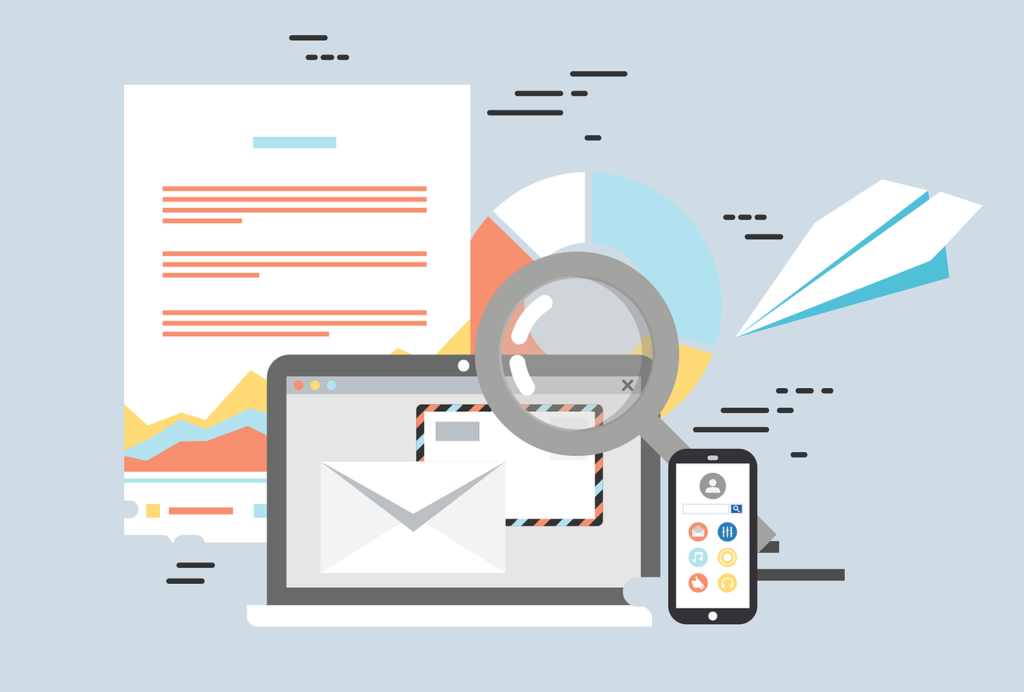This Article has been revised, edited and added to, by Poulomi Chakraborty.
- Why Keywords in Email Marketing?
- The Foundation: Understanding Your Audience
- Crafting Compelling Subject Lines
- Email Content and Keywords
- Enhancing Click-Through Rates with Keyword-Rich CTAs
- The Role of Personalization
- Monitoring and Adapting to Metrics
- Conclusion: The Convergence of Keywords and Email Success
In the vast realm of digital marketing, email remains one of the most potent channels. Especially for startups, email marketing presents a direct line to potential and existing customers, offering personalized engagements, promotions, and updates. However, with inboxes increasingly crowded and attention spans dwindling, the challenge is no longer just about sending emails but ensuring they get opened. This is where the art of keyword research intersects with email marketing, offering a strategy to significantly boost open rates.
Can keyword research, often associated with SEO and content marketing, play a role in enhancing email campaigns? Absolutely! By understanding and leveraging the right keywords, startups can craft subject lines and email content that resonates deeply with their audience, compelling them to click open.
In this comprehensive guide, we’ll delve deep into the synergy between keyword research and email marketing, creating a roadmap for startups to optimize their emails, drive engagement, and bolster conversions.
Why Keywords in Email Marketing?

Keywords aren’t just for SEO—they’re a critical component of email marketing too. By weaving targeted keywords into your email campaigns, you’re speaking the language of your audience. This boosts the relevance of your emails and, by extension, their open rates.
Think about it: if your email resonates with what your subscribers are interested in, they’re far more likely to engage.
Now, why is this so crucial for startups? Well, in the early stages of your business, you’re still building your reputation and trying to establish trust. Each email you send is an opportunity to solidify your brand’s voice and affirm your value to your customers.
Using the right keywords can help communicate that you understand their needs and expectations.
Crafting Emails That Meet Expectations
Let’s dive deeper. When you use keywords that your potential customers are using, you align your content with their expectations. For instance, if you’re a digital marketing startup, keywords like “increase conversion rate” or “drive traffic” are likely phrases your audience is deeply interested in.
Incorporating these into your email subjects and bodies in a natural, engaging way can make the difference between an opened email and one that’s ignored.
Moreover, think about the journey your reader is on. They might start with a problem or a need, which they express through search terms. By mirroring these terms in your emails, you’re essentially telling them, “Hey, we get it, and we’ve got the solution you need.” This alignment builds a connection that encourages open rates and, importantly, fosters trust.
How to Integrate Keywords into Your Emails
So, how do you do it? It’s not just about stuffing keywords into your emails. The process should be much more thoughtful:
- Keyword Identification: Start with thorough research. Utilize tools like Google Keyword Planner or SEMrush to find what your target audience is searching for. Look at trends in your industry, and pay close attention to the language your customers use on social media, in forums, and in feedback to you.
- Subject Line Mastery: The subject line is your first, and sometimes only, chance to make an impression. Make sure it includes your primary keyword in a way that feels natural and compelling. For example, instead of “Our tool helps increase conversion,” try “How to boost your conversion rate effortlessly.”
- Preheader Perfection: This is the snippet of text that appears next to your subject line in many email clients. It’s another valuable place to insert relevant keywords. Think of it as a secondary pitch that supports your subject line.
- Email Body Content: Here’s where you can expand with more detail. Use keywords throughout the body to reinforce your message and improve the alignment with subscriber interests. However, ensure the usage flows naturally and adds to the clarity and persuasiveness of your content.
Tailoring Keywords to Various Customer Segments
Customization doesn’t end at just including keywords. For startups, especially, it’s vital to tailor your approach to different segments of your audience. Not everyone on your email list is looking for the same solution.
Segment your audience based on their behaviors, such as previous purchases, website activity, and engagement with past emails. This allows you to personalize your keywords and content further, making your emails even more relevant and effective.
For example, you might send an email focused on “cost-effective marketing strategies” to early-stage startups and “scaling your business with advanced marketing tactics” to more established companies. This level of personalization shows an understanding of and an ability to address diverse needs, which can significantly boost your open rates.
Evaluating Your Keyword Strategy’s Effectiveness
Finally, it’s not just about implementing a strategy; it’s about constantly refining it. Use analytics to track how different keywords perform in terms of open rates and click-through rates. Experiment with A/B testing to see what resonates most with your audience.
Perhaps ‘increasing engagement’ performs better than ‘boosting engagement.’ These insights will allow you to optimize your email campaigns continually and grow closer to your audience with every send.
By integrating a thoughtful keyword strategy into your email marketing efforts, you not only increase the chances of your emails being opened but also build a stronger, more trusting relationship with your audience. And for startups, where every connection counts, this could be the key to rapid growth.
The Foundation: Understanding Your Audience
Before you can effectively use keywords or craft compelling email content, you must first understand who you’re talking to. This foundational step is often overlooked, yet it’s crucial for startups aiming to gain traction in a competitive market. Understanding your audience means more than just knowing their demographics; it involves grasping their challenges, desires, and digital behaviors.
Building a Detailed Audience Profile
The process begins with data. Gather as much information as you can about your potential customers. This includes basic demographics like age, gender, and location, but also deeper insights such as purchasing behavior, online activity, and personal interests.
Tools like Google Analytics, social media analytics, and customer surveys can provide a wealth of information. From this data, create detailed audience personas—semi-fictional characters that represent your ideal customers. These personas should reflect the variety of people who might use your service or product, helping you to tailor your marketing messages accurately.
Engaging with Your Audience
Once you have a clear picture of who your audience is, start engaging with them where they spend their time. For a startup, this could mean participating in specific online forums, commenting on blogs that your audience reads, or being active on the social media platforms where they are most engaged.
The goal here is to listen and learn. What questions are they asking? What problems do they need solving? This real-time engagement offers invaluable insights that can directly inform the keywords and content of your email marketing campaigns.
The Role of Feedback in Audience Understanding
Never underestimate the power of direct feedback. Encourage it through all channels, whether via email responses, social media interactions, or customer surveys. Feedback is a direct line to your audience’s thoughts and feelings about your brand and offerings. It also provides a unique opportunity to test your assumptions about what your audience cares about and how they speak about those cares.
Using Audience Insights to Refine Keywords
Armed with a comprehensive understanding of your audience, you can now refine your keyword strategy. If your audience uses certain phrases frequently or asks similar questions across various platforms, these are golden keywords for your emails.
For instance, if you’re a health tech startup and notice a lot of discussions around “affordable health monitoring,” this phrase should appear in your email campaigns.
Furthermore, understanding nuances such as the tone and formality your audience prefers can significantly enhance how you frame these keywords in your emails. If your audience consists mainly of millennials, a more casual and direct approach might resonate better than a formal one.
Adapting to Changes
Audiences evolve, and so should your understanding of them. Regularly update your audience profiles and stay active in their communities. Observe any shifts in language or priorities. An ongoing dialogue with your audience isn’t just beneficial; it’s essential. It ensures that your email marketing remains relevant and effective, adapting to meet the changing needs and interests of your audience.
Crafting Compelling Subject Lines

The subject line of your email acts as the front door to your message; it’s the first impression you make on your audience. In the competitive world of email marketing, especially for startups striving to establish their presence, the subject line determines whether that door opens or stays shut. A compelling subject line grabs attention, sparks curiosity, and feels relevant to the recipient, encouraging them to explore further.
Harnessing Curiosity and Clarity
Creating an effective subject line is a balancing act between curiosity and clarity. Your subject line must pique the interest of the reader while also giving them a clear indication of what to expect inside the email. This balance is crucial because while a mysterious, vague subject might intrigue some, it can frustrate others if it doesn’t provide enough context about the email’s content.
For instance, instead of a generic subject like “Monthly Newsletter,” try something more specific and engaging like “Discover the 3 Secrets to Boosting Your SEO This Month!” This tells the recipient exactly what they’re going to learn, which aligns with their interests and adds an element of intrigue with the promise of ‘secrets.’
Personalization Wins
Personalization is more than just inserting a recipient’s name into the subject line—it’s about tailoring the content to meet their specific needs and interests. Use the data you’ve gathered about your audience to segment your email list. This allows you to craft subject lines that resonate more deeply with different groups. For example, if you have a segment of small business owners, a subject line like “Exclusive Strategies for Small Businesses to Increase Online Sales” would be far more appealing than a one-size-fits-all message.
The Power of Urgency and Scarcity
Incorporating a sense of urgency or scarcity can effectively increase open rates, as people are driven by the fear of missing out (FOMO). However, this tactic must be used sparingly and honestly to maintain trust and integrity in your brand. Phrases like “Limited time offer” or “Only a few spots left” encourage immediate action but should only be used when truly applicable.
Testing and Optimization
One of the most powerful tools at your disposal is A/B testing. This involves sending two variations of your subject line to a small percentage of your list to see which one performs better. This data-driven approach takes the guesswork out of what resonates with your audience. Consider testing different aspects of your subject line, such as the inclusion of numbers, the use of questions versus statements, or the tone of the language.
Keeping It Mobile-Friendly
With the majority of emails now being opened on mobile devices, it’s essential to consider how your subject lines will look on smaller screens. A good rule of thumb is to keep your subject lines under 50 characters to ensure that they are not cut off on mobile displays. Concise, direct subject lines often perform better, not just for visibility reasons but also for capturing attention quickly in a crowded inbox.
Email Content and Keywords

When it comes to email marketing, the content of your email is what keeps the audience engaged after the initial click. For startups, where every interaction counts towards building a lasting relationship, the integration of relevant keywords into your email content is crucial. However, this should be done thoughtfully to ensure the message remains genuine and compelling.
Integrating Keywords Naturally
Keywords shouldn’t disrupt the natural flow of your email content; rather, they should enhance the message by making it more relevant and search-friendly. Start by identifying the keywords that are not only popular among your target audience but also central to the message you want to convey in each email. These keywords can help guide the structure of your content, from the introduction to the call-to-action.
For instance, if you’re a software startup and your key product benefits include “streamlining workflow” and “increasing productivity,” these phrases should appear naturally in your email content. For example, you might begin your email with a sentence like, “Looking for ways to streamline your team’s workflow and boost productivity? Our latest tool might be the perfect solution.”
Balancing Information with Engagement
Your email should inform and engage. This means balancing informative content, which establishes your authority and provides value, with engaging content that keeps the reader interested. Storytelling can be an effective technique here. Incorporate brief customer stories or case studies that highlight how your product has solved problems or improved processes. This not only makes your email more interesting but also shows your keywords in action, providing context and demonstrating value.
Using Keywords to Segment and Personalize
Segmentation and personalization go hand in hand with effective keyword use. By segmenting your email list based on user behavior or demographic information, you can tailor your content more precisely. For instance, you might use different sets of keywords for different segments, reflecting their specific interests or needs.
A segment interested in “cost-effective marketing solutions” would respond better to content focused around budget-friendly strategies and tools, whereas a segment of C-level executives might be more interested in “enterprise solutions” and “scalability.” This approach ensures that your keywords and content align perfectly with the interests of each segment, increasing the relevance and impact of your emails.
Encouraging Action
Every email should encourage some form of action, whether it’s reading a blog post, signing up for a webinar, or trying out a new product feature. This is where your keywords can also play a role in your call-to-action (CTA). By using action-oriented phrases that include your keywords—like “Start streamlining your day with a free trial”—you make your CTA not only clear and compelling but also optimized for engagement.
Continuous Learning and Adaptation
Finally, the use of keywords in your email content is not a set-it-and-forget-it strategy. It requires continuous monitoring and adaptation based on performance metrics such as open rates, click rates, and conversions. Pay attention to how different keywords perform across different segments and types of content. Use A/B testing to refine your approach, testing different keywords in your subject lines, preheaders, and body content to see what resonates best with your audience.
Enhancing Click-Through Rates with Keyword-Rich CTAs
In email marketing, the call-to-action (CTA) is the pivotal moment where interest transforms into action. For startups looking to drive engagement and conversions, crafting CTAs with carefully chosen, keyword-rich language can significantly enhance the effectiveness of each campaign. The right keywords can make your CTA not only more visible but also more compelling to your target audience.
Crafting Keyword-Rich CTAs
When integrating keywords into your CTAs, it’s crucial to focus on relevance and action. Your keywords should reflect the immediate benefit or value that resonates with your audience’s needs and align with the content of your email. For instance, if your email content has been focused on “improving team productivity,” then a CTA like “Boost Your Team’s Efficiency Today!” uses both action-oriented language and relevant keywords effectively.
Balancing Clarity and Creativity
While keywords can enhance the SEO aspects of your CTAs and improve their relevance, clarity should never be sacrificed for the sake of creativity. Your CTA should clearly state what the reader will get by taking the action, using direct language that eliminates any ambiguity about what is being offered. For example, “Download Your Free Productivity Guide Now!” clearly communicates what the user can expect to receive, making the action to be taken obvious.
Testing and Optimizing CTAs
The optimization of CTAs is an ongoing process that benefits greatly from A/B testing. By experimenting with different phrasings, formats, and placements of keywords, you can learn what drives the best engagement with your audience. For example, testing “Start Your Free Trial” against “Activate Your Free Trial Now” can reveal subtle nuances in how your audience responds to different action words and urgency in your CTAs.
Using Urgency and Exclusivity
To further enhance click-through rates, incorporating a sense of urgency or exclusivity can be very effective. Keywords like “limited-time,” “exclusive,” or “last chance” can create a sense of scarcity and prompt immediate action. However, it’s crucial that such tactics are used truthfully and sparingly to maintain trust and credibility with your audience. An example of using these principles might be “Claim Your Exclusive Offer Before It Expires!”
Visuals and Placement
Beyond just the words used, the visual presentation and placement of your CTAs are crucial in drawing attention and encouraging clicks. Ensure that your CTAs are designed to stand out with contrasting colors and are placed strategically within the email for maximum visibility. Keywords should be integrated in a way that they catch the eye along with the rest of the CTA, perhaps through bolding or color emphasis.
The Role of Follow-Up
Finally, enhancing click-through rates doesn’t end with a single email. Follow-up emails can be used to remind users of what they might miss out on if they don’t act. These emails can reuse and reinforce the keywords and CTAs from the original email, reminding the reader of the value proposition and urgency. For example, a follow-up email might include a CTA like, “Still Interested in Boosting Your Team’s Productivity? Act Now!”
The Role of Personalization

In the digital marketing realm, personalization is not just a feature—it’s a necessity for creating meaningful connections with your audience. For startups especially, which often face the challenge of building a customer base from scratch, personalization can be a game changer in nurturing relationships and boosting engagement across email campaigns.
Understanding the Depth of Personalization
Personalization goes beyond merely inserting a recipient’s name into an email. It involves using data-driven insights to deliver content that is relevant to the individual interests, behaviors, and needs of each subscriber. This can include tailoring messages based on purchase history, browsing behavior, geographical location, and even engagement levels with previous emails.
Segmenting Your Audience
Effective personalization starts with robust audience segmentation. By dividing your email list into smaller, more specific groups, you can craft messages that resonate deeply with different segments of your audience. For example, a startup might segment their audience into categories like new subscribers, frequent buyers, and once-active users now disengaged. Each group would receive content crafted to meet their unique needs and drive them towards specific actions.
Dynamic Content
Dynamic content is a powerful tool in the personalization toolkit. This technology allows you to change parts of your email content based on the characteristics of each recipient. For instance, subscribers from different regions might receive offers relevant to their local store, or a user who browsed web development services might receive more content related to these services in their email. Dynamic content makes each email feel bespoke, significantly enhancing the recipient’s engagement.
Predictive Personalization
Leveraging machine learning and artificial intelligence, predictive personalization analyzes past behavior to forecast future needs and preferences. Startups can use this advanced form of personalization to anticipate what content or products a subscriber might be interested in next. This proactive approach not only increases the relevance of each email but also positions your startup as attentive and customer-focused.
Crafting Personalized Calls to Action
A personalized call-to-action (CTA) can dramatically increase click-through rates by appealing directly to the recipient’s interests and needs. For example, if data shows that a subscriber has been exploring articles about SEO on your blog, your email can feature a CTA like “Master Your SEO Skills with Our Advanced Guide,” directly linking to that resource. This direct approach makes the action step feel more relevant and less intrusive.
Privacy Considerations
While personalization offers many benefits, it also requires careful handling of personal data. Subscribers are increasingly aware of and concerned about their privacy, so it’s crucial to be transparent about how you collect and use data. Always ensure that your practices comply with regulations like GDPR, and let subscribers know that they can trust you with their information.
The Benefits of Personalization Feedback Loops
Implementing a feedback loop can refine your personalization efforts. By analyzing how individual subscribers respond to different personalization strategies, you can continuously improve your segmentation and content customization. This iterative process ensures that your emails remain relevant and engaging over time, increasing the overall effectiveness of your email marketing campaigns.
Monitoring and Adapting to Metrics

In the fast-paced world of startup marketing, understanding and reacting to email campaign metrics isn’t just useful—it’s essential. Monitoring key performance indicators (KPIs) allows you to gauge the effectiveness of your email strategies and adapt to what resonates best with your audience. This continual process of refinement is critical to optimizing your engagement and ultimately, your conversion rates.
Key Metrics to Monitor
Several metrics are fundamental to assessing the success of your email campaigns. Here’s a breakdown of the most critical ones:
- Open Rates: This metric tells you the percentage of recipients who opened your email. It helps gauge the initial appeal of your email, primarily your subject line.
- Click-Through Rates (CTRs): CTRs measure the percentage of email recipients who clicked on one or more links contained in your email. This metric is crucial for understanding how engaging your email content is and how effective your CTAs are.
- Conversion Rates: This is the percentage of recipients who completed a desired action, such as filling out a form or purchasing a product, which can be directly attributed to the email campaign.
- Bounce Rates: The rate at which your emails are rejected by the recipients’ mail servers. This can indicate problems with your email list quality or deliverability issues.
- Unsubscribe Rates: The rate at which people opt-out of your email list after receiving an email. This can signal issues with content relevance or frequency.
Utilizing Analytics Tools
To track these metrics, utilize email marketing tools and platforms that offer comprehensive analytics. Tools like Mailchimp, HubSpot, and Campaign Monitor provide dashboards where these metrics are not only displayed but also interpreted in context. These platforms often offer insights into trends over time, which can help identify what works and what doesn’t on a larger scale.
Analyzing and Interpreting Data
Monitoring metrics is only useful if the data is analyzed and interpreted correctly. For instance, a high open rate paired with a low click-through rate might suggest that while your subject lines are effective, your email content isn’t compelling enough to drive action. Or, a high unsubscribe rate might indicate that your emails are too frequent or not relevant enough for your audience.
Adapting Based on Feedback
The key to leveraging metrics is adaptability. Use the insights gathered from your analytics to make informed decisions about how to tweak your email campaigns. For example:
- If open rates are low, test different subject lines with A/B testing to find more effective formulations.
- If click-through rates are disappointing, consider revising your CTA design and placement or enhancing the relevance and appeal of the content around the links.
- Adapt your email frequency and segmentation strategies based on unsubscribe and bounce rates to better align with your audience’s preferences.
Implementing Changes and Testing
Once changes are implemented, it’s essential to test and measure how those adjustments impact your metrics. Continue to use A/B testing for elements like subject lines, email layouts, and CTAs. This iterative process helps refine your approach continuously.
Learning from Every Campaign
Each email campaign offers a learning opportunity. Regularly scheduled reviews of campaign performance can foster a culture of continuous improvement. Discuss what worked, what didn’t, and hypothesize why — then apply these learnings to future campaigns. This cycle of monitoring, analyzing, adapting, and testing is crucial for growth and optimization in email marketing.
Conclusion: The Convergence of Keywords and Email Success
In the expansive arena of digital marketing, email remains a steadfast pillar. For startups looking to carve a niche, establish brand loyalty, or drive conversions, the importance of email marketing cannot be underscored enough. But as with all things digital, success lies in the details. And in the world of emails, those details often revolve around the right keywords.
Marrying keyword research with email marketing isn’t just a strategy; it’s a philosophy. It’s about understanding and anticipating the needs, desires, and behaviors of your audience. Every keyword incorporated, every subject line crafted, and every CTA created is a testament to a brand’s commitment to serving its audience.
For startups, this approach is invaluable. In an environment where resources are limited and every engagement counts, optimizing emails through keyword research ensures that efforts yield maximum results. It’s not just about boosting open rates; it’s about forging genuine, lasting connections with every click.
In wrapping up, the journey of integrating keyword research into email marketing may seem intricate, laden with strategies, tools, tests, and analytics. Yet, at its core, it’s a simple endeavor—understanding your audience and delivering value with every email. And as the digital landscape evolves, this ethos, supported by effective keyword research, will continue to guide startups towards email marketing success.
Read Next:
- 51+ Outstanding Email Marketing Tools to Skyrocket ROI
- 11 Best SMS Marketing Software: Our Picks!
- 11 Marketing Analytics Tools to Elevate Your Data-Driven Strategies
- Top 11 Demand Generation Tools to Skyrocket Your Lead-Gen!
- Top 9 Data Virtualization Tools: Which One Should You Pick?





















Comments are closed.